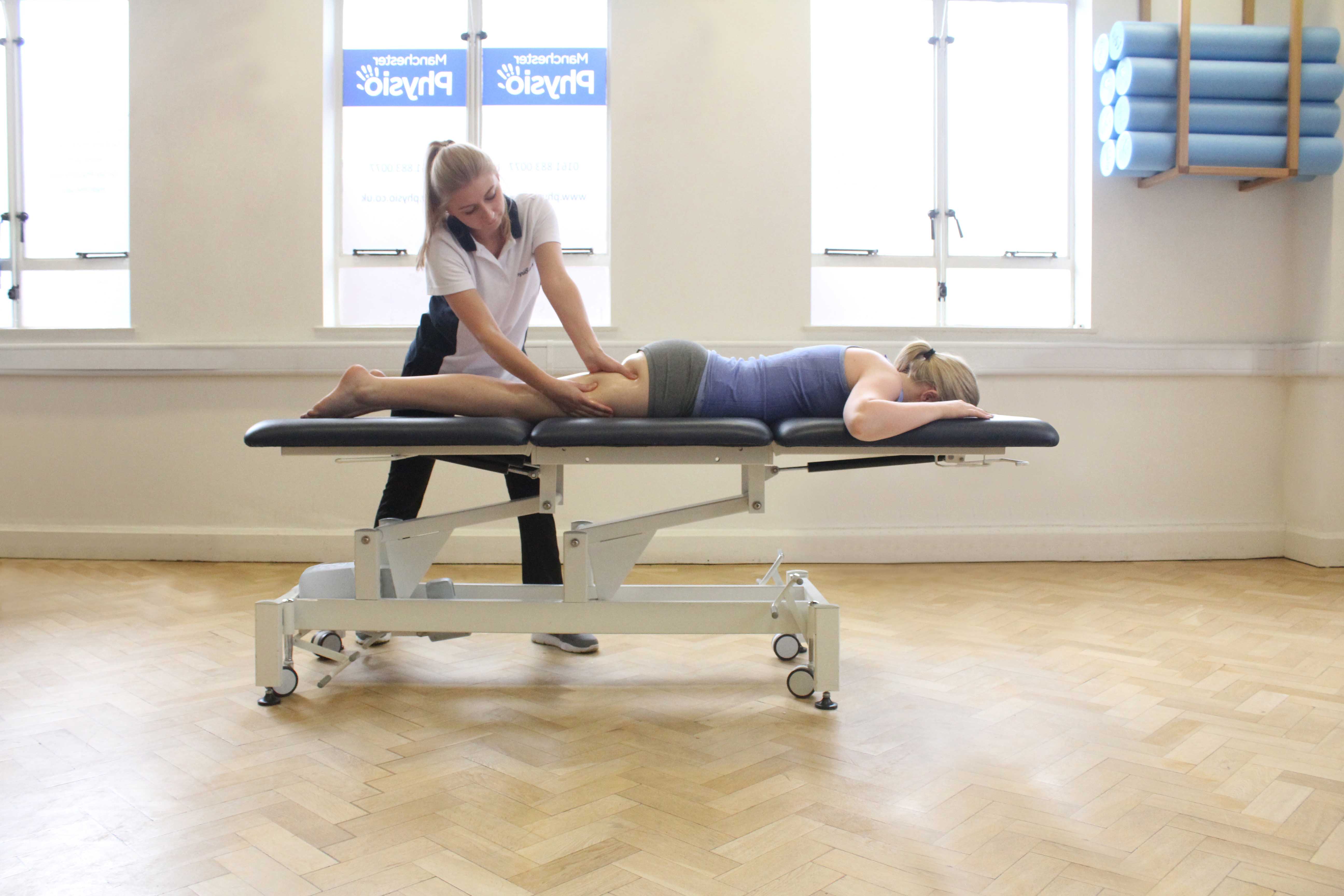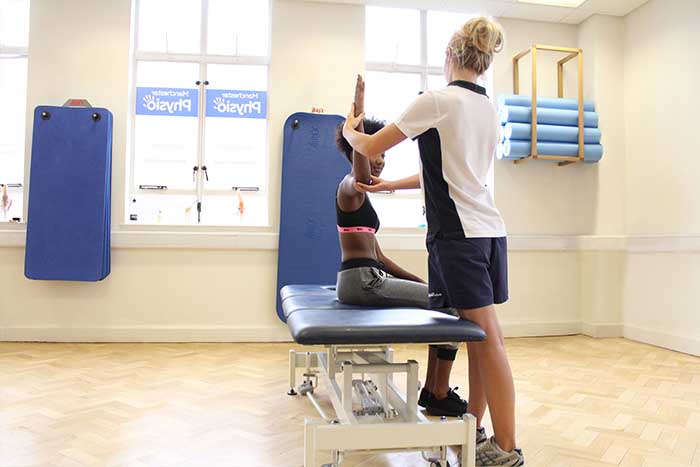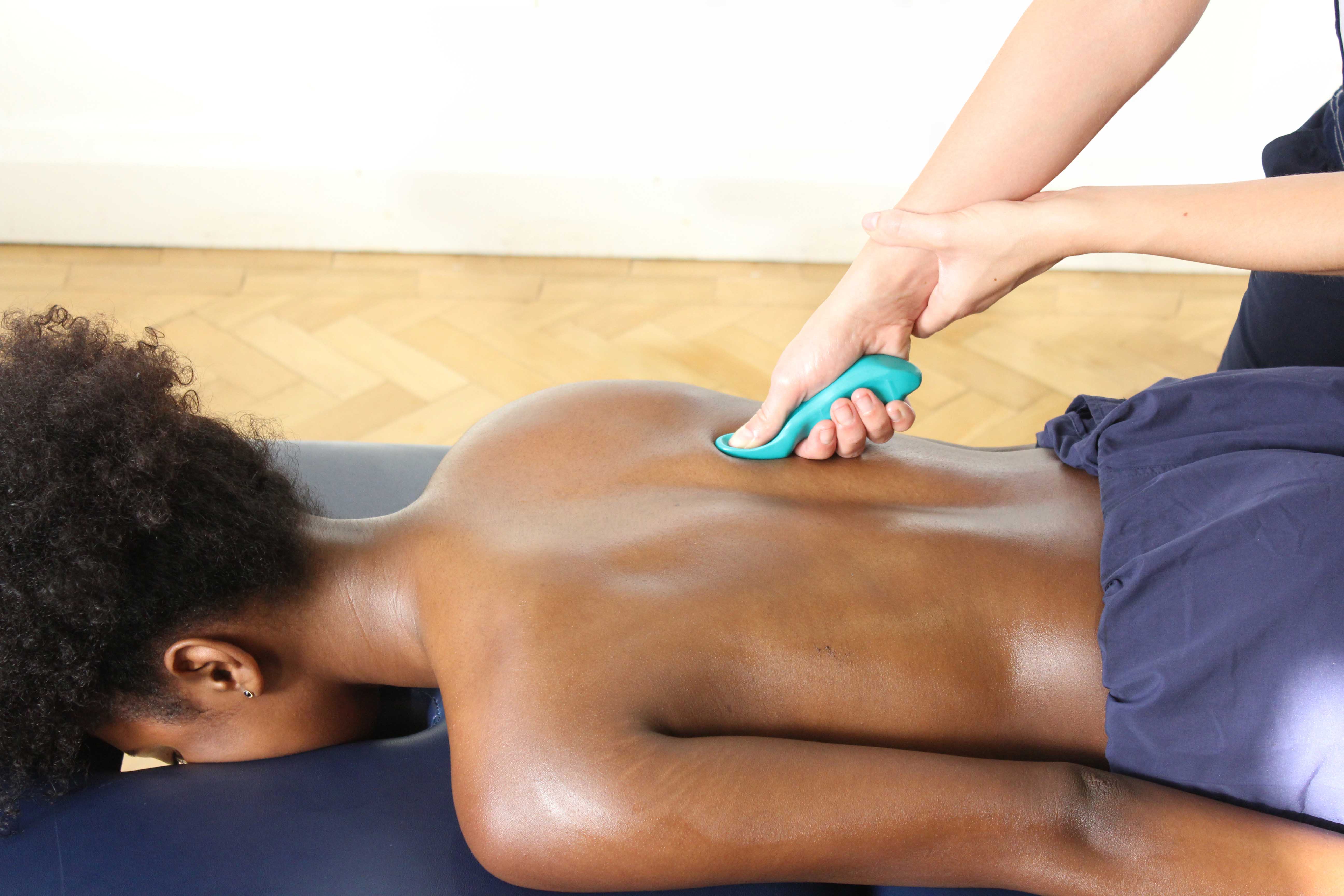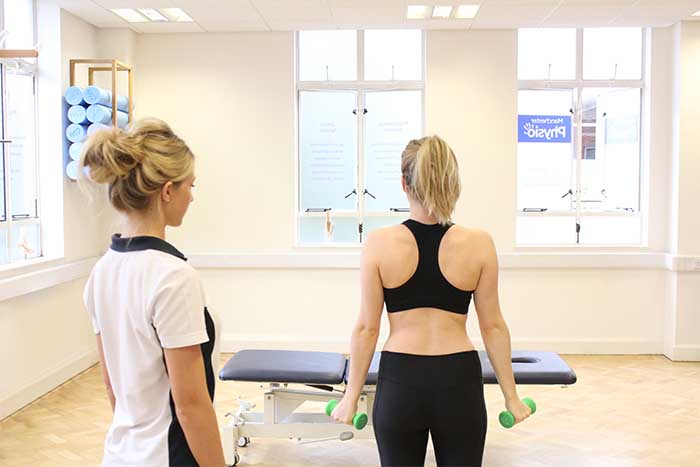A massage can often benefit a person by reducing muscle spasms. Muscle spasm can occur for a wide range of reasons. Some of the most common causes of muscle spasms include; muscle dehydration, poor circulation, lack of stretching before intense exercise, exercising in heat and over exerting a muscle during exercise or activity. Muscle spasms are an involuntary contractions that cause pain to increase. Muscle spasms can be mild and are most commonly known as a "twitch" or they can be severe, most commonly known as "cramp". Our massage therapists at Physio.co.uk reduce muscle spasms through massage to help decrease pain and improve relaxation.
What are the most appropriate types of massage to reduce muscle spasm?
A variety of massage types can be used to reduce muscle spasms. The massage types most commonly used include:
 Above: Soft tissue massage of bicep femoris muscle
Above: Soft tissue massage of bicep femoris muscleThe most common massage types used to reduce muscle spasms include deep tissue massage, remedial massage and Swedish massage.
A deep tissue massage is often used to reduce muscle spasms. Muscle spasms can be caused by the overexertion of muscles causing tension to build-up. A build-up of tension can cause muscles to involuntarily contract, otherwise known as a muscle spasm. A deep tissue massage can reduce muscle spasms by relieving the build-up of tension. A deep tissue massage gets deep within muscle tissues in order to stretch, loosen and relax the muscle to therefore relieve tension.
Muscle spasms can be reduced through remedial massage. A remedial massage focuses on the manipulation of muscles in order to relax a person both physically and mentally. Muscular fatigue is another common factor that causes muscle spasms. A remedial massage relieves muscular fatigue by pulling and stretching muscles, increasing lymphatic flow and allowing muscle relaxation. Increasing lymphatic flow removes waste products from the muscle causing fatigue more efficiently. Removal of waste products through remedial massage helps to reduce muscle spasms.
A Swedish massage is commonly used to reduce muscle spasms A Swedish massage encourages an increase in circulation to the treatment area by creating friction between the skin and fingers. It is quite often that muscle spasms occur due to a lack of circulation. Poor circulation results in waste products building up and a lack of available oxygen and nutrients to keep the muscle healthy. A build-up of waste products and lack of oxygen and nutrients can cause fatigue and muscle weakness, resulting in muscle spasm. Increasing circulation of both blood and lymph flow improve the removal of waste products and availability of oxygen and nutrients. Improving the removal of waste products and availability of oxygen and nutrients, prevents muscular fatigue and weakness and reduces muscle spasm.

What techniques are used to reduce muscle spasm?
A range of techniques can be used to reduce muscle spasm. The most common techniques used include:
 Above: Trigger point massage using a therapy aid to help dissapate muscle spasm
Above: Trigger point massage using a therapy aid to help dissapate muscle spasmEffleurage is regularly used to reduce muscle spasm. Effleurage is a gentle technique that involves long, directional strokes performed with flattened hands and fingers. Effleurage is an effective technique used to increase blood flow, reduce muscle tightness and relieve muscle tension. Exercises that involve holding a specific position for a long period of time or overusing a muscle during the exercise or activity can increase the amount of muscle spasms that occur. Effleurage is used to stretch and loosen the overworked muscle in order to reduce tension and prevent or reduce muscle spasms.
Kneading is often used to reduce muscle spasm. Kneading involves applying a firm pressure in order to pull and squeeze muscles. The pulling and squeezing action used increase friction created, improving blood flow. Improving blood flow through kneading, increases circulation, reduces muscle tightness, relieves muscle tension and decreases muscle fatigue. All of the conditions kneading can decrease are all common causes of muscle spasm. Relieving symptoms of muscle spasms therefore reduces how often they occur within a muscle.
Muscle spasms are reduced through trigger pointing. Trigger pointing involves applying a firm pressure to trigger points found in the centre of muscle fibres. Trigger points occur due to a build-up of muscle tightness and tension, often caused by overuse of a muscle. Trigger points can cause muscle spasms as they disable a muscle from functioning correctly by restricting their range of movement. Applying pressure to a trigger point restricts blood flow to the area which is commonly known as an ischemic reaction. Applying pressure breaks down the trigger point and eventually the person will feel a numbing sensation. After the numbing sensation occurs, pressure is released, encouraging blood flow to increase. Breaking down trigger points increases a muscle range of movement and reduces muscle spasm.
When can a massage help to reduce muscle spasm?
Reducing muscle spasm through massage can help a person in many ways. The most common situations reduced muscle spasm can help include:
Pain can be decreased when muscle spasms are reduced. When a muscle spasms, the involuntary contraction causes a short burst of pain. The pain a person feels can vary depending on the intensity or severity of the spasm. If muscle spasms occur frequently within the same muscle or on different areas, muscles tend to tire and fatigue due to the constant contraction of the muscle using up its energy. Muscle fatigue can increase the "achy" pain many people often feel. Reducing muscle spasms decreases the short bursts of pain and also prevents muscle from fatiguing. Preventing muscles from fatiguing further reduces pain.
Reducing muscle spasms can help post event. Tired and weak muscles are more prone to muscle spasms. Muscle spasms increase pain and can often prevent a person from relaxing. After an event, muscles are usually overworked, full of tension and often dehydrated due to either weather or a lack of liquid intake. Overworked, tense and dehydrated muscles are a few of the most common causes of muscle spasms resulting in the increase in pain and poor relaxation a person can get. Reducing muscle spasms helps to decrease pain and muscular fatigue after the event. Decreasing pain and muscular fatigue allows the person to relax and rest following the event and return to training as soon as possible.

What are the physiological effects of massage to reduce muscle spasm?
Various physiological effects occur during a massage to help reduce muscle spasm. The physiological effects that most commonly occur include:
The most common physiological effects that occur during a massage to reduce muscle spasms include increased temperature, removal of waste products and increased oxygenation.
Increasing temperature can help reduce muscle spasm. Increased temperature involves the use of a range of techniques to create friction between the skin and fingers in order to increase temperature of both superficial and deep tissues. Friction created between the skin and fingers causes circulation to improve. An improvement in circulation is what causes muscle temperature to increase. Muscle spasms can be caused by tension built up within a muscle due to overuse or a lack of stretching pre and post event.
Muscle spasm is reduced when the removal of waste products increases. The removal of waste products is where stimulation of the lymphatic system increases lymphatic flow through lymph vessels. An increase in lymphatic flow occurs in order to remove waste products from the body more efficiently. A build-up of waste products such as lactic acid can occur after exercise or an event. Lactic acid is one of the main waste products responsible for muscular fatigue, weakness and pain. A build-up of lactic acid can increase the occurrence of muscle spasms in the worked muscles. Removing waste products more efficiently, decreases the level of lactic acid in the muscle resulting in a reduction of muscle spasms.
Increased oxygenation often occurs to help reduce muscle spasm. Increased oxygenation involves an increase in blood flow occurring in order to supply muscles and cells within the body with an increase in oxygen. Oxygen is used as both energy and a source of nutrition for muscles, maintaining muscular health and strength. A lack of energy within muscles can cause muscle spasms to increase. Muscle spasms can further tire muscles due to the contraction of muscle fibres using up more energy. Increasing oxygenation through massage prevents muscles from tiring and increases the availability of energy. Increasing the availability of energy to be used can reduce muscle spasms.
Summary
Reduced muscle spasm includes the relief of muscular tension and fatigue caused by the overuse or over stretch of a muscle. The most common massage types used to reduce muscle spasm include deep tissue massage, remedial massage and Swedish massage. A wide range of techniques including effleurage, kneading and trigger pointing can be used to reduce muscle spasm. Reducing muscle spasm through massage can help to decrease pain and reduce the effects that occur after an event. A variety of physiological effects are produced through massage including increased temperature, the removal of waste products and increased oxygenation in order to reduce muscle spasm. Our massage therapists at Physio.co.uk reduce muscle spasm through massage to help increase relaxation and decrease restriction.
How can I arrange a massage to reduce muscle spasm?
The easiest way to arrange a massage to reduce muscle spasm at Physio.co.uk is to email us at office@physio.co.uk or call us on 0800 033 7800.
You can also book an appointment online and save £10

 0330 088 7800
0330 088 7800


































